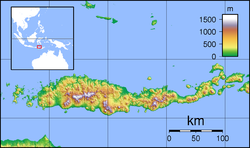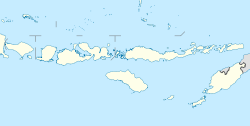West Manggarai Regency
West Manggarai Regency
Kabupaten Manggarai Barat | |
|---|---|
Regency | |
 Coat of arms | |
 Location within East Nusa Tenggara | |
 West Manggarai Regency | |
| Coordinates: 8°38′41″S 119°52′58″E / 8.6448°S 119.8828°ECoordinates: 8°38′41″S 119°52′58″E / 8.6448°S 119.8828°E | |
| Country | |
| Province | |
| Capital | Labuan Bajo |
| Government | |
| • Regent | |
| • Vice Regent | Maria Geong |
| Area | |
| • Total | 1,212.93 sq mi (3,141.47 km2) |
| Population (2020 Census)[1] | |
| • Total | 256,317 |
| • Density | 210/sq mi (82/km2) |
| Time zone | UTC+8 (ICST) |
| Area code | (+62) 385 |
| Website | manggaraibaratkab |
West Manggarai Regency (Indonesian: Kabupaten Manggarai Barat) is one of the eight regencies which comprise the island of Flores, located in the province of East Nusa Tenggara (Nusa Tenggara Timur) in Indonesia. It covers a land area of 3,141.47 km2, and had a population of 221,703 at the 2010 Census, rising to 251,689 at the 2015 Intermediate Census and to 256,317 at the 2020 Census.[2] The regency's capital is the town of Labuan Bajo.
Geography[]
The regency includes the western portion of Flores island (Pulau Flores) and several small islands mainly lying to the west of it, including the two largest islands, Komodo (Pulau Komodo) and Rinca (Pulau Rinca) as well as others such as Seraya Besar (Pulau Seraya Besar), Seraya Kecil (Pulau Seraya Kecil), Bidadari (Pulau Bidadari) and Longgos (Pulau Longgos). The total area of West Manggarai Regency is 10,193.47 square kilometres (3,935.72 sq mi), with a land area of 3,141.47 square kilometres (1,212.93 sq mi) and a sea area of 7,052 square kilometres (2,723 sq mi). The population as at the 2015 Census was 251,689 inhabitants, which rose to 256,317 at the 2020 Census.[3]
Administration[]
At the time of the 2010 Census West Manggarai Regency was divided into seven districts (kecamatan), but a further five districts have subsequently been created by the division of existing districts. These are tabulated below with their areas and their 2010 and 2020 Census populations.[4] The table also includes the number of administratiave villages (rural desa and urban kelurahan) in each district, and its post code.
| Name | Area in sq.km |
Pop'n Census 2010 |
Pop'n Census 2015 |
Pop'n Census 2020 |
No. of villages |
Post code |
|---|---|---|---|---|---|---|
| Komodo (a) | 813.53 | 41,258 | 48,812 | 53,724 | 19 | 86763 |
| Boleng (b) | 486.56 | 16,567 | 18,834 | 18,925 | 11 | 86754 |
| Sanonggoang | 360.19 | 25,113 | 14,441 | 14,229 | 15 | 86758 |
| Mbeliling | 231.53 | (c) | 13,058 | 13,758 | 15 | 86757 |
| Lembor | 145.68 | 49,732 | 32,753 | 33,653 | 15 | 86753 |
| Welak | 319.19 | 19,100 | 21,533 | 21,389 | 16 | 86762 |
| Lembor Selatan (South Lembor) |
275.87 | (d) | 23,538 | 23,461 | 15 | 86761 |
| Kuwus | 54.55 | 40,365 | 24,788 | 13,673 | 12 | 86752 |
| Ndoso | 124.95 | (e) | 19,579 | 20,032 | 15 | 86750 |
| Kuwus Barat (West Kurus) |
42.66 | (e) | (e) | 10,695 | 10 | 86751 |
| Macang Pacar (f) | 174.64 | 29,568 | 34,353 | 15,936 | 13 | 86756 |
| Pacar | 112.12 | (g) | (g) | 16,842 | 13 | 86755 |
| Totals | 3,141.47 | 221,703 | 251,689 | 256,317 | 174 |
Notes: (a) includes the 139 islands off the west coast of Flores, of which the largest are Komodo and Rinca; the district also includes the most westerly part of the Flores mainland, including the regency capital of Labuan Bajo. (b) includes the offshore islands of Pulau Boleng and Pulau Longos.
(c) The 2010 Census population quoted for Sanonggoang District includes the figure for the new Mbeliling District, cut out of it between 2010 and 2015.
(d) The 2010 Census population quoted for Lembor District includes the figure for the new Lembor Selatan District, cut out of it in the same period.
(e) The 2010 Census population quoted for Kuwus District includes the figure for the new Ndoso District, cut out of it in the same period, while the 2010 and 2015 Census populations quoted for Kurus District additionally include the figures for the new Kurus Barat District, cut out of it in 2018.
(f) includes the offshore islands of Pulau Medang and Pulau Sebabi.
(g) The 2010 and 2015 Census populations quoted for Macang Pacar District include the figures for the new Pacar District, cut out of it in 2018.
Demographics[]
Religion[]
Most of the population of West Manggarai Regency are Christianism, which is 78.56%, of which the majority are Catholicism 77.76% and Protestantism 0.80%. There is also a large proportion of the population adheres to the religion Islam which is 21.39%, and the rest are Hinduism 0.4% and Buddhism less than 0.01%.[5]
Ethnic[]
The Manggarai people inhabits Manggarai Regency, West Manggarai and East Manggarai, which is located on the island of Flores, East Nusa Tenggara Province. The total population is about 350,000 people.
The Manggarai language consists of several dialects, such as Pae, Mabai, Rejong, Mbaen, Pota, Central Manggarai, East Manggarai and West Manggarai dialects. The four leading dialects may be the languages of separate ethnic groups that were subservient to the Manggarai people in ancient times.[6]
The Komodo people inhabits Komodo Village, Komodo District, West Manggarai. The fishing village is inhabited by about 800 families. The population stands at 2,000 people. The majority are fishermen and some are active as Rangers in Komodo National Park.[7]
- Bajau
The Bajo or Bajau people are the indigenous tribes of the archipelago originating from the Sulu Islands, Philippines. Bajo migrated to various places in the Malay Archipelago, one of which was Labuhan Bajo, West Manggarai.
Labuan Bajo means the harbor for the Bajo people. This ethnic group is a nomadic ethnic group in the sea, it is not surprising that many call it the Sea Gypsy.[8]
Development issues[]
Rural development
The West Manggarai Regency, along with other nearby regencies on Flores, has a long and hot dry season. Programs of tree-planting have been initiated in recent years which are helping improve the local environment.[9] These activities include efforts to promote continued attention to the cultivation of sugar palms (Arenga pinnata).[10]
Education
Education facilities in the region are limited, especially in the outlying areas. Some non-government organisations help, for example, with the provision of books for children to isolated villages.[11]
Tourism
Various local community groups in different parts of the regency work to promote the local tourist industry through, for example, the development of local dance troupes and foods from local areas.[12] In Liang Ndara village, which has been designated as a tourist site, there are programs to teach English in the local community to support the tourist industry,[13]
Mount Mbeliling (Indonesian: Gunung Mbeliling), one of the highest peaks in the regency (1,325 meters) is a well-known destination for climbers and tourists to the regency.[14] The area around Mt Mbeliling, which is rich in bird life, attracts bird-watching groups[15]
Tourism[]
Sano Nggoang[]
Sano (means Mount) Nggoang is 513 hectares (1.9 sq. mi.) of volcanic crater lake with depth of around 600 meters (1968.5 ft.), the deepest lake of its kind in the world.[16]
Shark and manta ray sanctuary[]
In late August 2013, the local authority designated that all regency's marine and coastal water up to 12 nautical miles offshore occupied 7,000 square kilometer area as a shark and manta ray sanctuary (includes sea around Komodo Island).[17]
See also[]
- Details for Treking in the Mt Mbeliling area.
- List of places to visit in West Maggarai
- Kokotuku Peninsula
References[]
- ^ Badan Pusat Statistik, Jakarta, 2021.
- ^ Badan Pusat Statistik, Jakarta, 2021.
- ^ Badan Pusat Statistik, Jakarta, 2020.
- ^ Badan Pusat Statistik, Jakarta, 2021.
- ^ "Provinsi Nusa Tenggara Timur Dalam Angka 2017" (PDF). BPS Nusa Tenggara Timur (in Indonesian). Archived from the original (PDF) on 2017-09-18. Retrieved 2 December 2017.
- ^ History of the Manggarai people in NTT
- ^ Getting to Know the Uniqueness of the Komodo Tribe, the Original Ancestor of Komodo Island
- ^ The History of Labuan Bajo, the Land of Birth of the Native Fish-Man Race of the Archipelago
- ^ Markus Makur, 'Marselinus Agot: Three million trees for Manggarai Raya', The Jakarta Post, 30 September 2011. Also Markus Makur, 'Aventinus Sadip: Greening to ease warming', The Jakarta Post, 2 April 2013.
- ^ Markus Makur, 'Abraham Manggas: Rescuing sugar palms', The Jakarta Post, 14 August 2012.
- ^ Eva Muchtar, 'Gardens of Learning', The Jakarta Post Weekender, 26 April 2012.
- ^ Markus Makur, 'Yoseph Ugis: Never give up', The Jakarta Post, 28 December 2012.
- ^ Markus Makur, 'Tourism: Farmers learn English to welcome more foreign tourists', The Jakarta Post, 22 March 2013.
- ^ Markus Makur, Onesimus Patrio Nyamang: Climbing mountains', The Jakarta Post, 3 September 2012.
- ^ Markus Makur, 'Samuel Rabenak: From fascination to preservation', The Jakarta Post, 8 March 2012.
- ^ "Sano Nggoang Danau Vulkanik Terdalam di Dunia yang Eksotik" (in Indonesian). October 7, 2012.
- ^ "West Manggarai establishes shark, manta ray sanctuary". September 12, 2013.
- Regencies of East Nusa Tenggara
- Flores Island (Indonesia)




